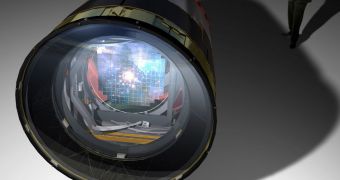A research team handling the development of an advanced future telescope has just received Critical Decision 1 approval from the US Department of Energy. This means that the project can move forward with devising a schedule, compiling a budget, and creating more in-depth designs.
The announcement was made on April 24. All projects that are managed by the DOE need to undergo a series of five critical decision stages. This is likely to happen for the Large Synoptic Survey Telescope (LSST), a behemoth observatory that was first proposed 14 years ago.
Its main feature is the 3.2 billion-pixel camera, which will analyze the Universe through an 8.4-meter aperture. The installation will be primarily focused on studying dark matter and dark energy, but also Kuiper Belt Objects, near-Earth asteroids, exploding supernovae and similar objects.
The Paul-Baker/Mersenne-Schmidt-type, wide-angle observatory is to be built near the Gemini South and Southern Astrophysical Research Telescopes, at Cerro Pachón, in Chile. The location is around 2,682 meters (8,800 feet) above sea level, guaranteeing pristine observation conditions.
An impressive feature of the new installation will be its 3.5-degree, 9.6-square-degree wide field of view. This design will enable it to analyze the entire night sky once a week, for around 10 years.
This survey will enable investigators to construct a comprehensive image of Earth's surrounding, and determine which asteroids or comets is a threat to our planet, if that is the case. In addition, the study could yield new data on the nature of dark matter and dark energy.
Experts want to study this by measuring the weak gravitational lensing occurring in the night sky, especially in areas where no visible matter is present. Since light traveling through can only be bent by gravity, any deviations would imply the presence of dark matter in these regions.
When completed, LSST is expected to produce around 30 terabytes of data per night (6 million gigabytes annually). Google has already announced its intention to make some of this information available as a real-time, interactive map of the night sky.
According to researchers managing the project, the telescope will be able to achieve first light just four years after construction begins. If everything goes according to plan, the azimuth-mounted observatory will see its first stars in the third quarter of 2015, Space reports.
The 3.2-billion-pixel digital camera at the heart of the LSST may be constructed by the SLAC National Accelerator Laboratory, in the US, if the DOE provides the necessary funding.

 14 DAY TRIAL //
14 DAY TRIAL //